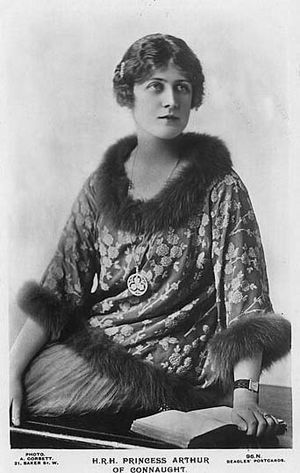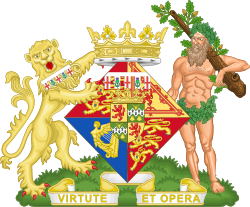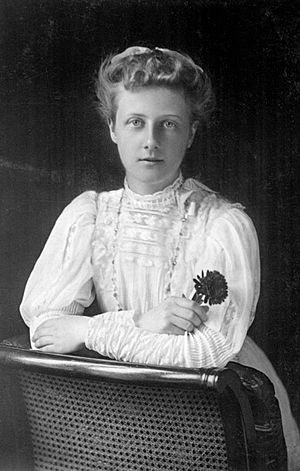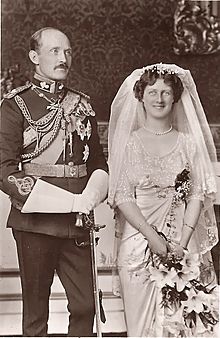Princess Alexandra, 2nd Duchess of Fife facts for kids
Quick facts for kids Princess Alexandra |
|
|---|---|
| Princess Arthur of Connaught Duchess of Fife |
|

Photograph, 1910s
|
|
| Born | Lady Alexandra Victoria Alberta Edwina Louise Duff 17 May 1891 East Sheen Lodge, Richmond, England |
| Died | 26 February 1959 (aged 67) St John's Wood, London, England |
| Burial | 3 March 1959 St Ninian's Chapel, Braemar, Scotland |
| Spouse | |
| Issue | Alastair Windsor, 2nd Duke of Connaught and Strathearn |
| Father | Alexander Duff, 1st Duke of Fife |
| Mother | Louise, Princess Royal |
Princess Alexandra, 2nd Duchess of Fife (born 17 May 1891 – died 26 February 1959) was a very special member of the British Royal Family. She was the oldest grandchild of King Edward VII. She was also a first cousin to George VI.
Alexandra and her younger sister, Maud, were unique. They were the only female descendants of a British King or Queen to be officially called "Princess" and "Highness." This was quite rare for someone born on their mother's side of the family.
Contents
Early Life and Family History
Alexandra's father was Alexander Duff, 1st Duke of Fife. He became the Duke of Fife when he married Princess Louise of Wales in 1889. Princess Louise was the oldest daughter of the future Edward VII. This made Alexandra's mother a Duchess.
Alexandra was born in Richmond, England, on 17 May 1891. After her sister Maud was born in 1893, her parents had no more children. This was a problem because the title of Duke of Fife usually only passed down to sons.
To make sure the title continued, Queen Victoria made a special rule in 1900. She said that if there were no sons, the title could pass to Alexandra and her sister. Because of this, when her father died in 1912, Alexandra became the Duchess of Fife in her own right.
When she was born, Alexandra was called Lady Alexandra Duff. This was because she was the daughter of a Duke. Even though she was fifth in line to the throne, she wasn't called a "Princess" or "Royal Highness" at first.
Alexandra and her sister were special because they were related to two different British monarchs. They were descendants of both William IV and his niece, Queen Victoria.
Becoming a Princess
On 9 November 1905, Alexandra's grandfather, King Edward VII, made a big change. He decided that Alexandra and her sister Maud would officially be called "Princess" and "Highness." This meant they had a special royal rank, not just from their father, but directly from the King.
Around 1910, Alexandra was secretly engaged to Prince Christopher of Greece and Denmark. But their parents found out and didn't approve, so the engagement ended.
Marriage and Family
On 15 October 1913, Princess Alexandra married her cousin, Prince Arthur of Connaught. Their wedding took place at the Chapel Royal in St. James's Palace, London.
Prince Arthur was the only son of Prince Arthur, Duke of Connaught and Strathearn. This Duke was the third son of Queen Victoria. This made Alexandra and Prince Arthur first cousins once removed.
After their marriage, Alexandra was known as HRH Princess Arthur of Connaught. This was because wives usually share their husband's title.
Princess Alexandra and Prince Arthur often helped out with royal duties. They represented her uncle, George V, and later her cousin, George VI. She also served as a Counsellor of State for several years.
The couple had one child, a son named Alastair Windsor, 2nd Duke of Connaught and Strathearn. He was born on 9 August 1914.
A Career in Nursing
When World War I started, Princess Alexandra found her true calling: nursing. In 1915, she began working as a full-time nurse at St. Mary's Hospital, Paddington. She continued this work until the war ended.
After the war, she kept training and became a registered nurse in 1919. She even won a top prize for a paper she wrote about a medical condition called eclampsia. She also worked at Queen Charlotte's Hospital, focusing on women's health. Her supervisors were very impressed with her skills.
When her husband became the governor-general of South Africa, Princess Alexandra was a great support. She was friendly and interested in hospitals, child care, and maternity work. She used her nursing knowledge to make helpful suggestions.
In 1923, she returned to London and continued her nursing career. She worked at University College Hospital and Charing Cross Hospital. She was known as Nurse Marjorie at one hospital. She specialized in surgery and was very good at it. In July 1925, King George V recognized her hard work by giving her the Royal Red Cross award.
When World War II began in 1939, Princess Alexandra again used her nursing skills. She chose to work at a casualty clearing station for soldiers from Dunkirk. Later, she opened her own nursing home called the Fife Nursing Home. She paid for it herself and ran it as the matron for ten years.
Sadly, her only son, Alastair, died unexpectedly in 1943.
Later Life and Legacy

By 1949, Princess Alexandra suffered badly from rheumatoid arthritis, which made it hard for her to move. She had to close her nursing home. She moved to her London home in St John's Wood.
She wrote two books about her life for her friends and family. One was called A Nurse's Story (1955). The other was Egypt and Khartoum (1956). In this book, she described a shipwreck she was in back in 1911. She, her sister, and mother almost died. Her father was injured and later passed away because of it.
Princess Alexandra was working on another book about hunting in South Africa when she died on 26 February 1959.
She asked to be cremated. Her ashes were placed in St Ninian's Chapel, Braemar, which is on the Mar Lodge estate in Scotland.
Titles and Honours
Titles and Styles
- 17 May 1891 – 9 November 1905: Lady Alexandra Duff
- 9 November 1905 – 29 January 1912: Her Highness Princess Alexandra
- 29 January 1912 – 15 October 1913: Her Highness Princess Alexandra, Duchess of Fife
- 15 October 1913 – 26 February 1959: Her Royal Highness Princess Arthur of Connaught
Honours and Awards
- Royal Red Cross (for her nursing work)
- Dame Grand Cross of the Most Venerable Order of St John of Jerusalem
- Royal Family Order of King Edward VII
- Royal Family Order of King George V
Other Roles
- Colonel-in-chief, Royal Army Pay Corps (an honorary military role)
- Counsellor of State (1944)
Coat of Arms
 Coat of arms of Princess Alexandra, 2nd Duchess of Fife |



